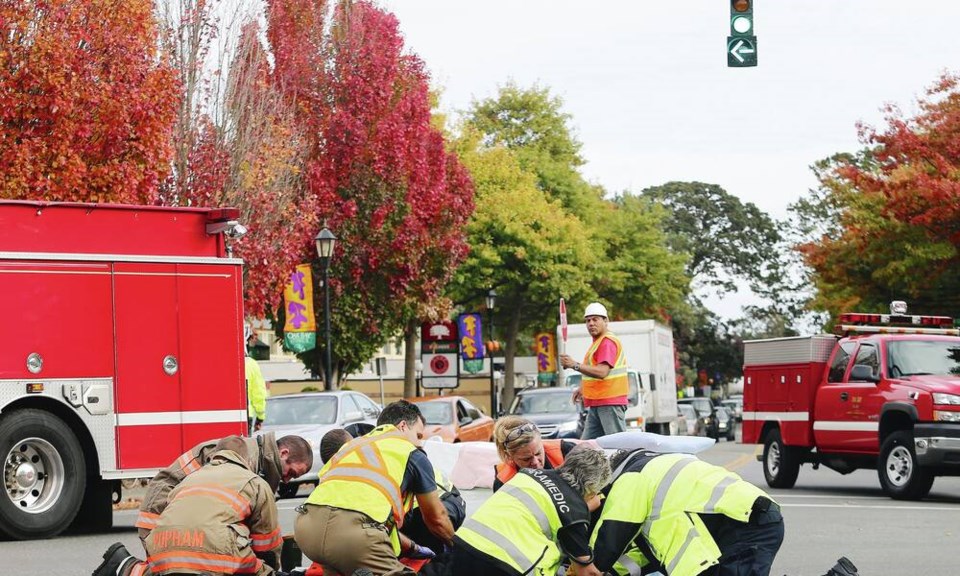The horrific July 2021 crash in downtown Vancouver that seriously injured a pedestrian and father, and killed his two-year-old daughter, Ocean, provides a disturbing perspective on the world of those drivers amongst us who just don’t get it.
Seyed Moshfeghi Sadeh, then 29, was acquitted in B.C. provincial court last month on criminal code charges of dangerous driving causing death and bodily harm. Back in 2021, Moshfeghi Sadeh drove his SUV through a light which had been red for 20 seconds at 47 km/h and broadsided a McLaren sports car. The impact forced Moshfeghi Sadeh’s vehicle over the sidewalk striking Hivva and his little girl, who were standing on the corner.
Crown counsel in the case argued that Moshfeghi Sadeh’s driving “[was] the functional equivalent of driving with a blindfold on for a city block at rush hour in downtown Vancouver,” but the judge in the case disagreed. Provincial court judge Kathryn Denhoff ruled that simply driving through a red light did not amount to a “marked departure” of driving behaviour necessary to secure a conviction for some of the criminal code’s most serious offences.
It’s hard to disagree with the ruling. If running a red light became a marked departure of driving norms around here the jails would be overflowing. There have been several arguments made in the media that a more appropriate charge would have been “driving without due care and attention” under B.C.’s motor vehicle act. That’s hindsight. Police and crown counsel undoubtedly analyzed that and took their best shot. The crown is however appealing the decision.
My perspective is a little different on this one. Why was Moshfeghi Sadeh behind the wheel in the first place?
According to media reports he is a novice driver, despite being in his 30s, and has racked up so many previous provincial driving offences that his record borders on being incomprehensible.
Since 2014, Moshfeghi Sadeh has incurred 24 driving offences, including: driving without a licence; excessive speeding; disobeying red lights; violating driver’s licence restrictions and; causing unnecessary noise — to name just a few.
It’s the understatement of the year to suggest: How can this guy still be on the road?
There will be a coroner’s inquest into the senseless death of two-year-old Ocean, though that will no doubt still be several years down the line — a failing of our system in its own right.
However, I’m fascinated by why drivers like this seem so deeply unaffected by the rules and the consequences that societies try to put in place to keep motorists safe.
A 2021 Australian study offers some insight.
Seventy-four per cent of certain drivers believed that they had better abilities than other drivers. These drivers, who admitted to speeding frequently, were also more likely to report being involved in crashes as well as having lost their licence. The study found that these frequent offenders were aware of the dangers in their behaviour but continued to offend anyway.
For these types of drivers, the risks, no matter how tangible, remain hypothetical and covered off by an inflated perception of their own abilities, often influenced by peers or even parents who condone speeding behaviour.
Other factors at play include tendencies toward thrill seeking, adopting the glamour of dangerous driving found in movies and other media — including the senseless and reckless behaviours often shown in big car makers’ commercials.
At the conclusion of the trial last month, Moshfeghi Sadeh’s lawyer said, “We have the greatest sympathy and compassion for the parents and the family of the deceased child and Mr. Hiiva for the injuries that he suffered … that has weighed very heavily on Mr. Moshfeghi Sadeh.”
Really? That’s hard to accept. Between Aug. 8 and Sept. 6 2023, his client breached his pretrial release order by being at large in Vancouver and during that time he was also charged with using a forged document — allegedly a fake driver’s licence.
I can only hope provincial motor vehicle administrators are having a hard look at this one.
Glove Box: A number of readers wrote in last week to correctly remind me about the use of downshifting your gears when descending a steep hill. I focused solely on the idea of using brakes sparingly to keep them cool and functional when negotiating hills. Gearing down, whether you’re driving a standard or automatic vehicle is important in lowering speed on steep hills — saving brake wear at the same time. But make sure when gearing down not to over rev the engine into red-line territory. Newer model vehicles now often use a “grade assist” feature which electronically decides your “gear” when driving.Ironically, traditional gears are no longer found in the latest continuously variable transmissions, which instead use computer-controlled belts and pulleys to make you go or make you slow.



